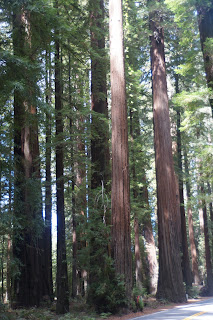TUESDAY,
AUGUST 25:
Left our campground around
8:30. Connected with Hwy 101 via Hwy 20 again. Bill didn't relish
the thought of driving that very curvy, up-and-down road again for
30+ miles. But it was the best of 3 bad options – there's just no
clean & easy way to get from the coast to 101, since the entire
coastal range of mountains lies between. But as one Californian
said, “Why do you choose to vacation in California? Is it because
of the flat landscape? Nooooooo! So stop complaining, you
flatlanders, about having to drive through mountains. If you don't
want to do that, take your next vacation in Nebraska!” She does
have a point!
The truck did make it over
fine, thanks to the new transmission, but it was still grueling –
worse than coming over east to west. The Californian quote above
notwithstanding, she wasn't pulling 8 tons! We stopped to pick up
some breakfast at McDonalds in Willitt, and then headed north for
the 200+ miles to Crescent City. We didn't really know how long a
trip it would be – how many more stretches of tight curves, steep
grades, etc., so we planned to allow all day if needed.
Very scenic most of the
way. Mostly through forested land., much of it Redwood forest. We
took one expressly scenic detour, a 33 mile stretch called Avenue of
the Giants. It parallels 101, and part of it is Humboldt Redwoods
State Park. It contains some of the largest stands of old growth
Coastal Redwoods in the world. It was absolutely magnificent. Even
though you see pictures of these trees, until you see them in person,
you just can't imagine the impact they make. Their tall dignified
grandeur transports you to a place where time stands still.
Though not the oldest nor the
largest living thing on earth (that honor goes to their relative, the
Giant Sequoias found in Yosemite and, of course, Sequoia Nat'l
Parks), they are the tallest. And many of these Coastal Redwoods do
obtain a very ripe old age – some up to 2,000 years – and the
associated mass.
A display at the Visitors Center: the metal plates depict what was happening in recorded human history at each ring of this 2,000 year old specimen:
It's fascinating to observe the
micro-climates here. We were in and out of fog all day . . . some
places were thick with it . . . then, a few minutes later, we'd be in
bright sunshine. Fog is essential for these Coastal Redwoods, and
some scientists worry that with rising average temperatures, the
summer fog will decrease to the point where the redwoods and the
creatures that depend on them will be endangered.
Arrived at our campground
just before 5:00. On first sight, it was absolutely beautiful –
widely spaced sites, wooded areas throughout the grounds, including
some redwoods. We'll explore it more tomorrow – tonight we just
recuperated from the day's journey, ate, and went to bed early.











No comments:
Post a Comment